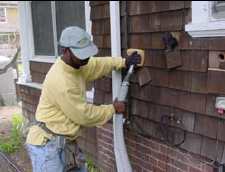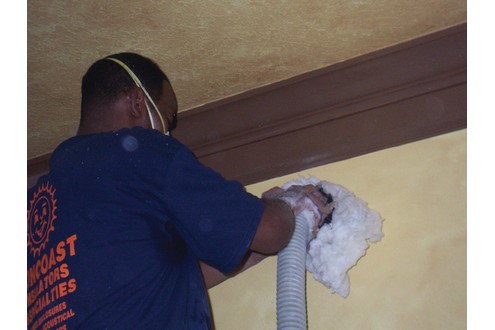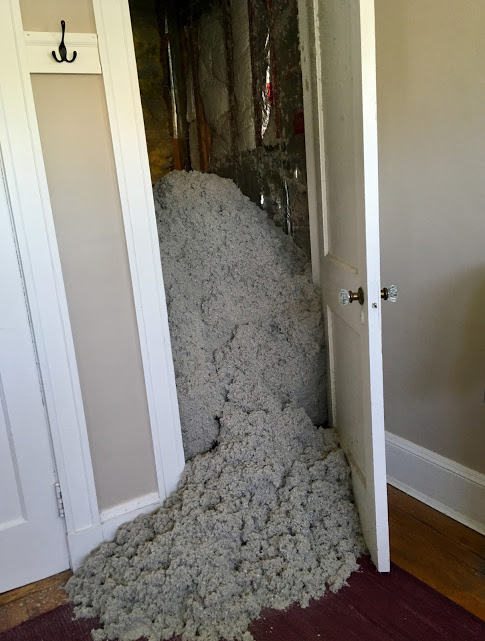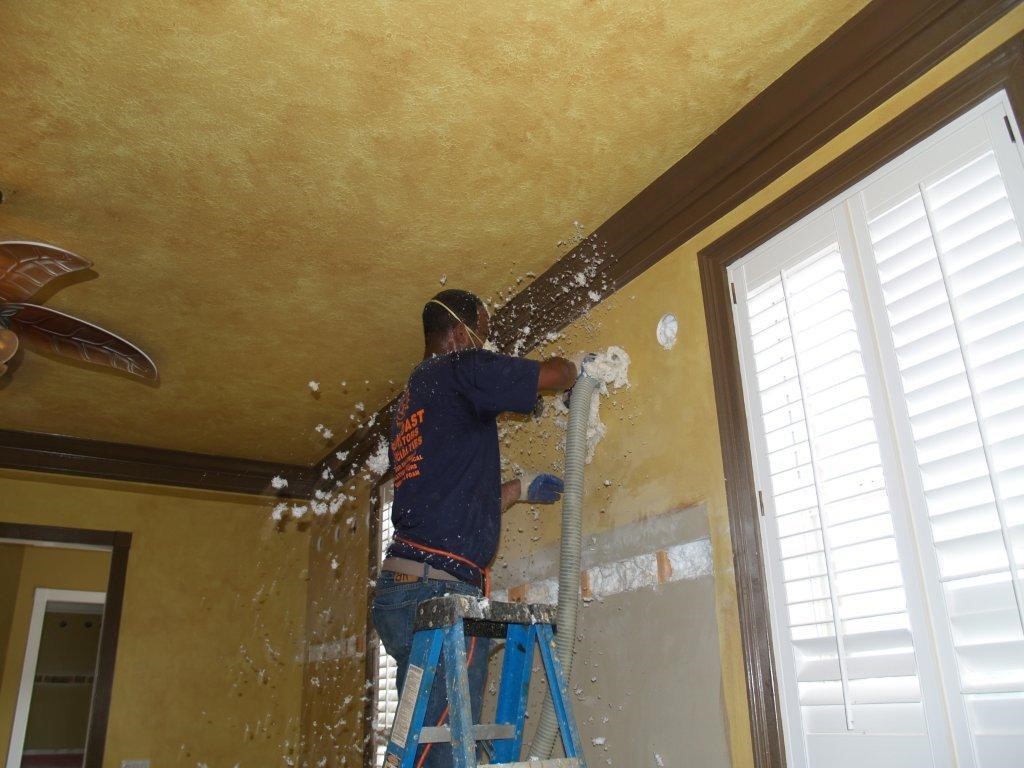Find out more and view our products here. Blow-in is an unbonded virgin fibrous glass blow-in insulation designed for broad applications for new-built and retrofitting housing.
 Blowing Cellulose Insulation Into Existing Walls
Blowing Cellulose Insulation Into Existing Walls
But blown-in insulation is ejected out of a large hose with plenty of aeration.
/Blowncelluloseinsulation-GettyImages-504647572-50aaeff502134673b9bfc18e4ae0bb58.jpg)
Blow in insulation walls. This system is installed by a network of nationwide approved installers. The insulation itself costs about the same for comparable R-values. 5 Things to Know About Blown-in Insulation 1.
Blowing-In Insulation Step-by-Step 1 Use a stud finder to locate studs in the wall. There are three. It is produced as a loose-fill product to be blown with a dedicated blowing machine and installation accessories.
To install blown-in insulation in existing walls holes are drilled. Insulating a completed wall with an insulation blower is easy. Foam has advantages over fiberglass insulation chiefly because it resists mold and mildew better than.
The Energy Saving Trust. Blow-in cellulose costs about 30 for. It is easily.
With a hole saw cut a small hole between 2 and 3 inches wide between two studs and near the top of the wall and place the cut portion asideyou will reattach this later. Cavity Wall Insulation With Blown Mineral Wool Cavity wall insulation involves the mechanical injection of a suitable insulant into the cavity using a specified system designed to ensure a complete fill. The hole is plugged and sealed and the siding is replaced.
Insulation is blown in densely packing the area between studs. It is a very versatile as far as its ease of installation is concerned but the one problem a homeowner can face is installing blown-in insulation inside existing walls. Adding insulation to the walls of an old house without any other precautions can result is rotting walls full of mold under certain circumstances.
Blow-in insulation is difficult for DIYers especially for wall cavities. Repeat this step between each pair of studs. A panel of siding is removed and a 3 hole is drilled.
It can be used on external walls and internal to provide a sound barrier between. A how-to on installing CertainTeeds OPTIMA Blown-in fiber glass insulation into interior and sidewall applications including application techniques and qua. Blown-in insulation fills between existing wall studs and ceiling joists quickly and easily.
Supafil Frame blowing insulation is an unbonded glass mineral wool which is blown into the cavities between the frames in timber frame walls. The insulation usually is made of a combination of fiberglass and treated cellulose. Blown-in insulation can be added to exterior walls quite easily.
The Plus Points Blown in insulation can offer incredible energy savings in homes where it is suitable. This insulation then fills the cavities making your house easier to heat by retaining the heat for longer. In a perfect world you would be able to unscrew invisible bolts remove drywall panels install.
Our blowing wool insulation is suitable for use in masonry cavity timber frame and party separating walls. Blown mineral wool is one of the recognised materials. This means of insulation has its disadvantages.
Use a drill and hole saw to make a penetration on center between each pair of studs into the top of the cavity. Instead of rolling out layers and cutting them to size you simply cut a hole in a wall and blow in the insulation. Use a stud finder to locate each stud and any horizontal blocks that exist at or near the center of the walls height.
This insulation is a flexible option. Blown-in insulation is a quick way to add insulation to your home. Supafil Frame blowing insulation is the insulation component of the Supafil Frame Blow-in-Blanket System.
Attic insulation can be a DIY. Blow in insulation is a fairly self-explanatory term. Comparison With Fiberglass Batts DIY-friendly.
It requires no mixing on site and is dry when installed adding no water to the building. Cost-effective insulation batts come in large squares that are unrolled. Blown insulation is a more recent development that greatly simplifies the application process.
You can put it in your walls attic crawl space and even under the floors. How to Add Insulation to Walls That Are Closed Injection Foam. Blown in Insulation and timber frame properties.
In other cases drilling holes in the walls or removing a couple courses of clapboard to blow insulation into the stud bays may work with no problems. It basically involves a specialist firm drilling holes in the outer leaf of your cavity wall in order to pump in insulation. Blown-in insulation refers to the method through which insulation is applied to an attic wall or crawlspace.
Spray foam insulation is applied with a specialized spray gun.
/Blowncelluloseinsulation-GettyImages-504647572-50aaeff502134673b9bfc18e4ae0bb58.jpg) What You Should Know About Blow In Cellulose Insulation
What You Should Know About Blow In Cellulose Insulation
 Insulating Stud Cavities In Existing Homes Greenbuildingadvisor
Insulating Stud Cavities In Existing Homes Greenbuildingadvisor
 Buyer S Guide To Insulation Blown In Fine Homebuilding
Buyer S Guide To Insulation Blown In Fine Homebuilding
 The Diminishing Returns Of Adding More Insulation
The Diminishing Returns Of Adding More Insulation
Insulating Walls Without Removing The Drywall How To Build A House
 Blown Insulation For Cavities Of Existing Exterior Walls Building America Solution Center
Blown Insulation For Cavities Of Existing Exterior Walls Building America Solution Center
 How Much Blown In Insulation Cost Us And How Much We Ve Saved
How Much Blown In Insulation Cost Us And How Much We Ve Saved
 This Is What Happens When You Blow Cellulose Insulation In Your Walls Youtube
This Is What Happens When You Blow Cellulose Insulation In Your Walls Youtube
 Sprayed Moisture Added Cellulose Insulation An Effect Way To Get Tightly Sealed Wall Cavities
Sprayed Moisture Added Cellulose Insulation An Effect Way To Get Tightly Sealed Wall Cavities
 Blown Insulation For Cavities Of Existing Exterior Walls Building America Solution Center
Blown Insulation For Cavities Of Existing Exterior Walls Building America Solution Center
 How To Insulate Interior Walls That Are Already Drywalled Hunker Wall Insulation Diy Blown In Insulation Interior Wall Insulation
How To Insulate Interior Walls That Are Already Drywalled Hunker Wall Insulation Diy Blown In Insulation Interior Wall Insulation
 Tips On Installing Cellulose Insulation As Do It Yourself Diy Project Or Blown In By Contractors
Tips On Installing Cellulose Insulation As Do It Yourself Diy Project Or Blown In By Contractors
 Double Wall Construction And Blown In Insulation In A Zero Energy Home Zeh Youtube
Double Wall Construction And Blown In Insulation In A Zero Energy Home Zeh Youtube
-
Digital Audio Output As their name implies the analog audio output transmits analog audio signalwhile the digital audio output transmits dig...
-
Past Participles are forms of verbs that express a completed action. Translate become in context with examples of use and definition. Past...
-
Weve tabbed out this guitar scales chart for you below. A Minor Scale Lessons - Scales. Pentatonic Minor Scale Guitar Patterns Chart Key O...
it's a good life pdf
It's a Good Life PDF Free Download . It's a Good Life. IT’S A GOOD LIFE By JEROME BIXBY Aunt Amy was out on the front porch, r...

